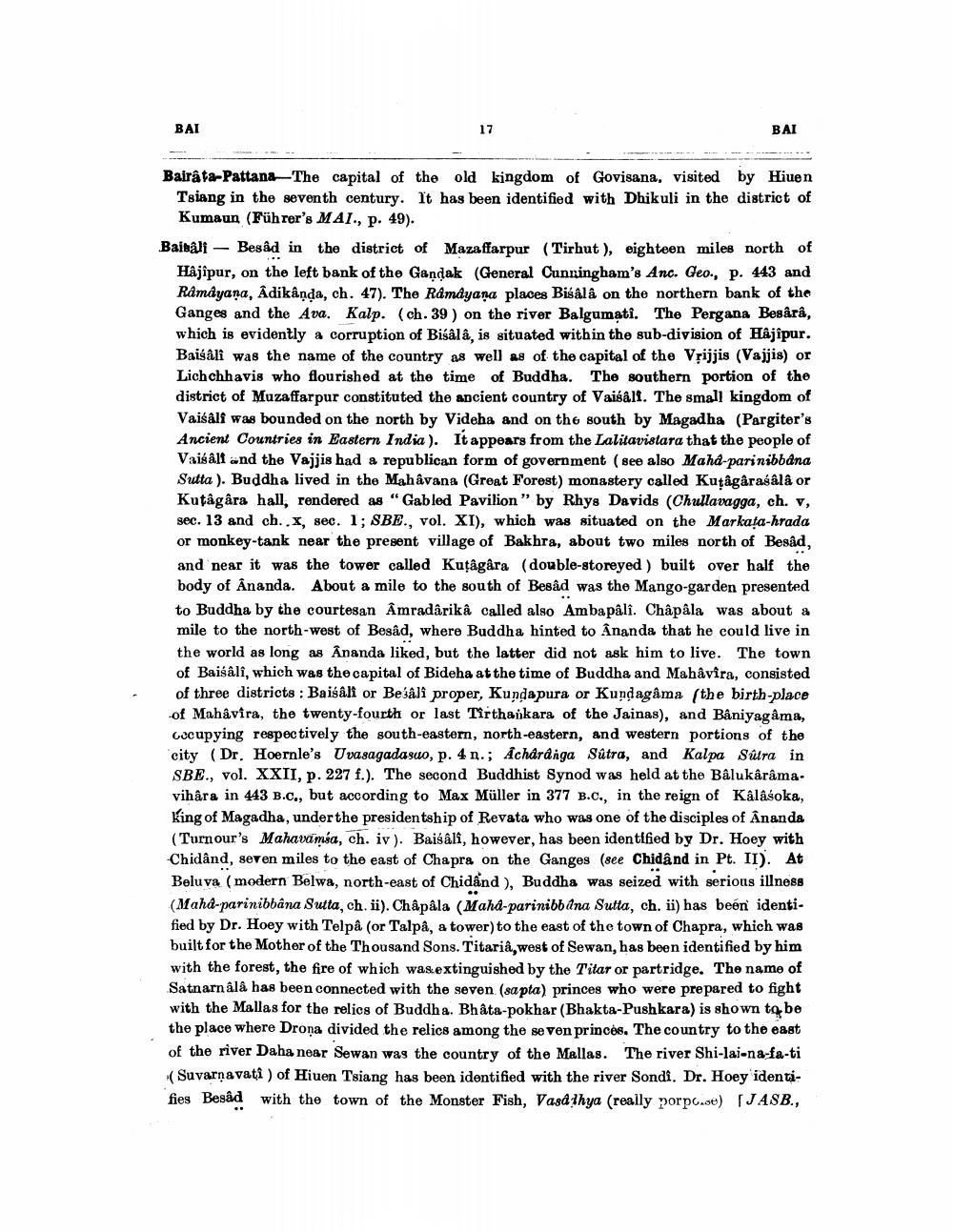________________
BAI
17
BAI
Bairâta-Pattana-The capital of the old kingdom of Govisana, visited by Hiuen Tsiang in the seventh century. It has been identified with Dhikuli in the district of Kumaun (Führer's MAI., p. 49).
Baibali - Besâd in the district of Mazaffarpur (Tirhut), eighteen miles north of Hâjîpur, on the left bank of the Gandak (General Cunningham's Anc. Geo., p. 443 and Ramayana, Adikânda, ch. 47). The Ramayana places Bisâlâ on the northern bank of the Ganges and the Ava. Kalp. (ch. 39) on the river Balgumati. The Pergana Besârâ, which is evidently a corruption of Bisâlâ, is situated within the sub-division of Hâjîpur. Baisâli was the name of the country as well as of the capital of the Vrijjis (Vajjis) or Lichchhavis who flourished at the time of Buddha. The southern portion of the district of Muzaffarpur constituted the ancient country of Vaisâli. The small kingdom of Vaisâli was bounded on the north by Videha and on the south by Magadha (Pargiter's Ancient Countries in Eastern India). It appears from the Lalitavistara that the people of Vaisâlf and the Vajjis had a republican form of government (see also Mahd-parinibbana Sutta). Buddha lived in the Mahâvana (Great Forest) monastery called Kuțâgâraśâlâ or Kutâgâra hall, rendered as "Gabled Pavilion" by Rhys Davids (Chullavagga, ch. v, sec. 13 and ch..X, sec. 1; SBE., vol. XI), which was situated on the Markata-hrada or monkey-tank near the present village of Bakhra, about two miles north of Besâd, and near it was the tower called Kuțâgâra (double-storeyed) built over half the body of Ananda. About a mile to the south of Besâd was the Mango-garden presented to Buddha by the courtesan Âmradârikâ called also Ambapâlî. Châpâla was about a mile to the north-west of Besâd, where Buddha hinted to Ananda that he could live in the world as long as Ananda liked, but the latter did not ask him to live. The town of Baisâlî, which was the capital of Bideha at the time of Buddha and Mahâvira, consisted of three districts: Baisâli or Besâli proper, Kundapura or Kundagama (the birth-place of Mahavira, the twenty-fourth or last Tirthankara of the Jainas), and Bâniyagama, Gccupying respectively the south-eastern, north-eastern, and western portions of the city (Dr. Hoernle's Uvasagadasao, p. 4 n.; Achârânga Sûtra, and Kalpa Sutra in SBE., vol. XXII, p. 227 f.). The second Buddhist Synod was held at the Bâlukârâmavihâra in 443 B.C., but according to Max Müller in 377 B.C., in the reign of Kâlâśoka, King of Magadha, under the presidentship of Revata who was one of the disciples of Ananda (Turnour's Mahavamsa, ch. iv). Baisâlî, however, has been identified by Dr. Hoey with Chidând, seven miles to the east of Chapra on the Ganges (see Chidând in Pt. II). At Beluva (modern Belwa, north-east of Chidand), Buddha was seized with serious illness (Maha-parinibbâna Sutta, ch. ii). Châpâla (Maha-parinibbana Sutta, ch. ii) has been identified by Dr. Hoey with Telpâ (or Talpâ, a tower) to the east of the town of Chapra, which was built for the Mother of the Thousand Sons. Titariâ,west of Sewan, has been identified by him with the forest, the fire of which was extinguished by the Titar or partridge. The name of Satnarnâlâ has been connected with the seven (sapta) princes who were prepared to fight with the Mallas for the relics of Buddha. Bhâta-pokhar (Bhakta-Pushkara) is shown to be the place where Drona divided the relics among the seven princes. The country to the east of the river Daha near Sewan was the country of the Mallas. The river Shi-lai-na-fa-ti (Suvarnavati ) of Hiuen Tsiang has been identified with the river Sondi. Dr. Hoey identifies Besâd with the town of the Monster Fish, Vasathya (really porpo.se) [JASB.,




